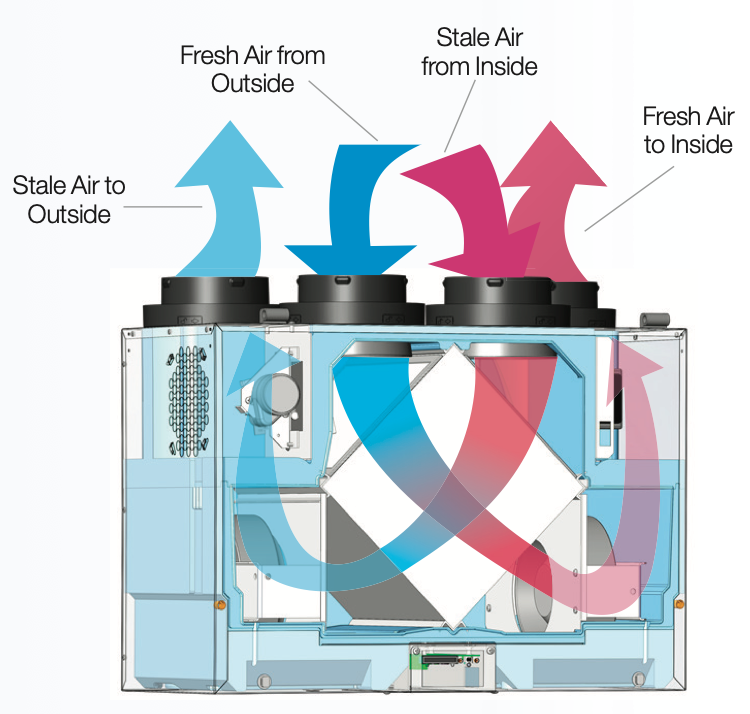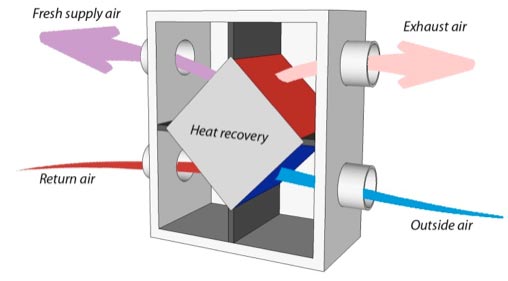HRV Explained for Families: Why It Matters
Wiki Article
Discovering the Benefits of Heat Recovery Ventilation for Power Effectiveness in Residences
Heat Recovery Ventilation (HRV) systems offer homeowners a practical strategy to improving power effectiveness. By reclaiming warmth from outbound air, these systems can considerably lower heating & cooling costs. In addition, they offer a steady supply of fresh air, enhancing interior air top quality and comfort levels. As home owners think about lasting options, comprehending the subtleties of HRV systems becomes significantly important. What aspects should one evaluate before making such a financial investment?Understanding Heat Recovery Ventilation Equipments

Exactly How HRV Improves Indoor Air Quality

Power Financial Savings: The Economic Advantages of HRV
Taking full advantage of power performance, heat recovery ventilation (HRV) systems supply substantial economic advantages for home owners. By recouping and recycling heat from exhaust air, HRVs noticeably reduce cooling and heating costs. This innovation can result in power savings of as much as 30%, depending on environment and usage patterns. Home owners typically see reduced utility expenses quickly after installment, making HRVs a monetarily smart financial investment with time. Furthermore, several areas provide motivations or discounts for energy-efficient upgrades, further boosting the monetary appeal. As power rates remain to rise, the cost-effectiveness of HRVs comes to be significantly clear. In general, the unification of HRV systems not only advertises energy effectiveness yet also adds to lasting financial savings for houses.The Environmental Impact of Heat Recovery Ventilation
A substantial environmental benefit of heat recovery ventilation (HRV) systems hinges on their ability to minimize total power consumption. By reclaiming warm from exhaust air and moving it to incoming fresh air, HRV systems lessen the requirement for energy-intensive home heating and cooling down methods. This reduction in power need adds to decrease greenhouse gas discharges, as less nonrenewable fuel source is needed to keep comfortable indoor temperatures. Additionally, HRV systems boost interior air high quality by successfully exchanging stale air with fresh outdoor air, lowering reliance on mechanical air conditioning systems that can hurt the setting. Overall, the application of HRV systems supports sustainable living methods and aligns with global initiatives to battle climate adjustment by advertising power efficiency in property setups.
Choosing the Right HRV System for Your Home
How can house owners guarantee they choose the best heat recovery ventilation (HRV) system for their demands? They ought to assess their home's size and design, as these factors influence airflow requirements. Next off, evaluating the system's effectiveness ratings is vital, as greater rankings suggest better efficiency and energy cost savings. House owners need to additionally consider installation and upkeep expenses, contrasting different brand names and models for value. Furthermore, it is essential to assess sound levels, as some systems run more silently than others. Consulting with a/c experts can give tailored suggestions based upon particular home problems. Finally, taking a look at user evaluations and service warranties can aid in making an educated choice, guaranteeing that the picked HRV system efficiently improves interior air high quality and power efficiency.Frequently Asked Questions

Just how Usually Should I Clean or Preserve My HRV System?
The frequency of cleansing or keeping a warmth recuperation air flow (HRV) system commonly depends upon usage and environmental variables. Normally, it is recommended to perform maintenance HRV Heat Recovery Ventilation every 6 months to ensure peak efficiency and air quality.
Can HRV Solutions Help In Reducing Moisture Degrees Indoors?
HRV systems can efficiently decrease interior moisture degrees by trading stagnant, humid air with fresh, drier air from outdoors. HRV Heat Recovery Ventilation. This procedure assists maintain a balanced interior atmosphere, enhancing convenience and preventing moisture-related problems
What Is the Lifespan of a Normal HRV System?
The lifespan of a normal heat recovery ventilation (HRV) system differs, generally lasting in between 10 to 15 years. Routine upkeep can extend its performance and operational life, making sure peak performance throughout its usage duration.Exist Any Kind Of Noise Concerns With HRV Solutions?
Noise worry about HRV systems can arise, particularly from follower operation. Several contemporary units are designed to decrease sound levels, guaranteeing they run quietly while preserving efficiency, which deals with potential disruptions in living atmospheres.Can I Install an HRV System Myself, or Do I Required an Expert?
The individual contemplated whether to mount the heat recovery ventilation (HRV) system personally or work with an expert. Typically, while do it yourself setup is possible, competence assurances proper functionality and compliance with neighborhood building regulations, enhancing system efficiency.Report this wiki page